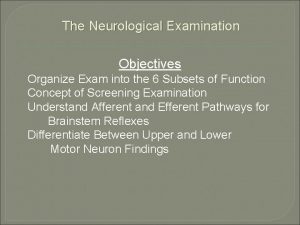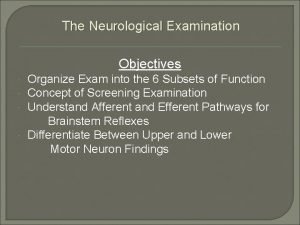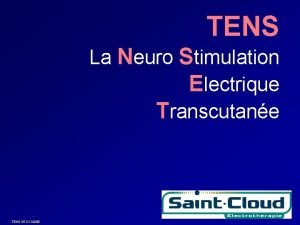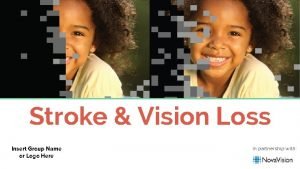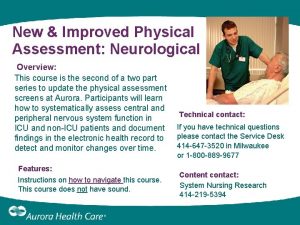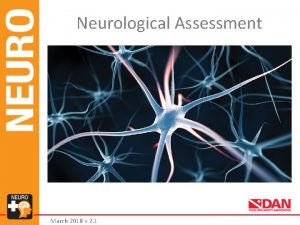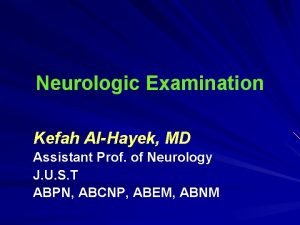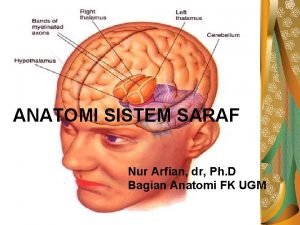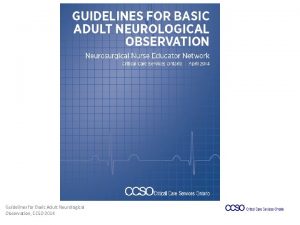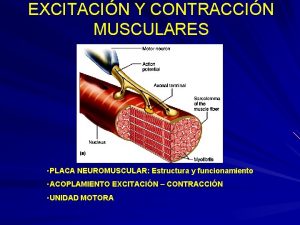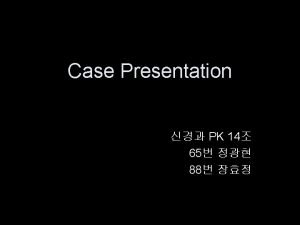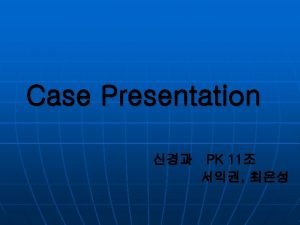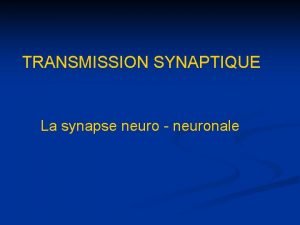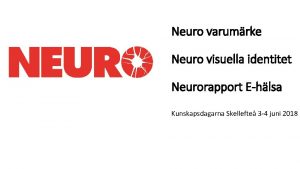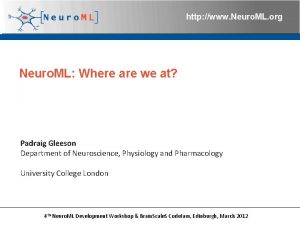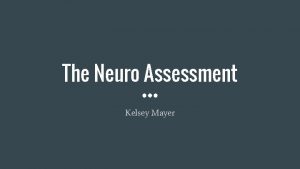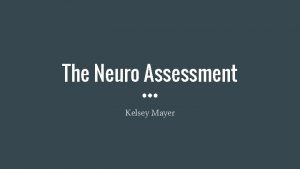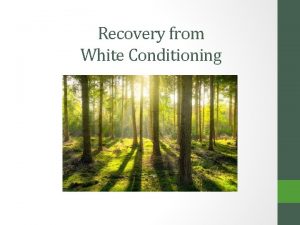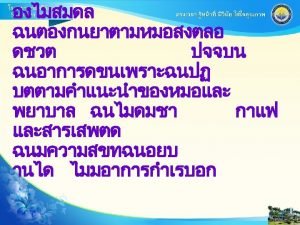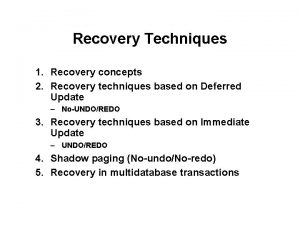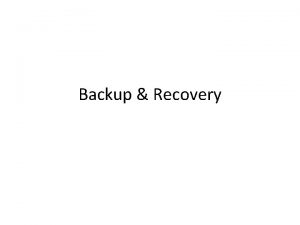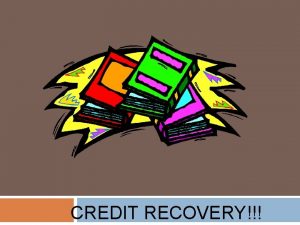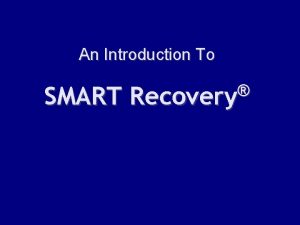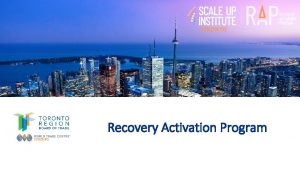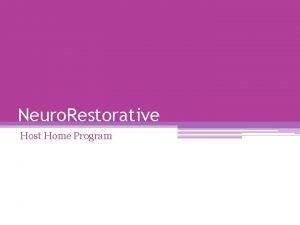NAD NEURO RECOVERY PROGRAM What is NAD NAD














- Slides: 14

NAD+ NEURO RECOVERY PROGRAM

What is NAD+ NAD (nicotinamide adenine dinucleotide) is a metabolic co-enzyme which continuously varies between the NAD and NADH compounds in the body. Enzymes are responsible for every activity of life. There are two primary classes of enzymes: digestive and metabolic. Metabolic enzymes are responsible for the structuring, repair, and remodeling of every cell, and the body is under a great daily burden to supply sufficient enzymes for optimal health. Metabolic enzymes operate in every cell, every organ and every tissue, and they need constant replenishment. NAD plays an essential role in the production of ATP (Adenosine triphosphate), the basic energy molecule in the body, and has more than 100 metabolic functions in our human biochemistry. • NAD Increases energy in brain cells • The brain consumes about one-third of all the energy produced by the body.

What is NAD+ Continued • (The body is made up of ~100 trillion cells) • NAD stands for nicotinamide adenine dinucleotide, which is the chemical term for a molecule that reacts with oxygen in the mitochondria in every cell of your body in order to create energy so you can move, breathe, pump blood, digest food, think, and generally, live your life. Lack of this essential cellular fuel is now recognized as a key feature of chronic fatigue, apathy, depression, anxiety, alcohol and drug addiction, weak immune system (infections and cancer), muscle pain and weakness, headaches, memory disturbance, sleep problems, focus and concentration defects and other chronic diseases. NAD deficiency may be an unrecognized epidemic of cellular disease.

What is NAD Energy Deficiency? • All human activities require energy. Research has indicated that 90% of our physical energy must be made available from the biochemical processes within our cells. Each cell in your body has a particular function that needs energy to do its job. This energy is produced by various chemical processes in the cells, in little “power plants”. We refer to such power plants as the mitochondrion. Glucose is the fuel for our power plants and is obtained from the food which we consume by means of digestion. Most processes in a power plant which releases energy however require a particular co-enzyme to produce energy. Without the co-enzyme, the power plant will simply not function. • NAD is such a co-enzyme and it maintains the processes in all power plants. When there is a deficiency in NAD, or too few power plants in the cells, there will be a metabolic energy deficiency. This metabolic energy deficiency is called a NAD Energy Deficiency (NED). This NED is insufficient chemical energy for life and can be defined as the physical state which develops when the body does not have enough NAD molecules and accompanying energy metabolic cofactors to generate enough metabolic energy on a cellular level to maintain the body in a constant state of health. Such a NED can result in a wide spectrum of NED related diseases. NED mostly manifests itself as chronic fatigue, chronic fatigue syndrome, substance abuse, depression, stress, anxiety and various other chronic illnesses.

Brain Dis-ease & Neurotransmitter Dysfunction

Brain Dis-ease • Neurotransmitters are chemicals in the brain that help to control states of consciousness, including moods. Serotonin and GABA down-regulate electrical activity in the brain, thereby contributing to calm, peacefulness, or less anxiety. Adrenaline and noradrenaline up-regulate electrical activity thereby promoting excitement, motivation, or, reducing depression and apathy. Dopamine is the “feel good” brain chemical. It is the dance of these electro-chemicals that produce emotional balance and feelings of well-being. • When the proper flow, or cascade, of these neurochemicals is impaired, or, the brain’s receptors are blocked, then a variety of problems can develop, including: • Mood instability • Irritability • agitation • hypersensitivity • Anxiety • Depression • Apathy • Impaired concentration • Trouble focusing • Despair

NAD+ Amino Acid Formulas • NAD+ is used in combination with special Intravenous and or Oral Amino Acids to detoxify neurons of chemical and metabolic toxins. • NAD+ AA’s restore neuronal connections and communication pathways. • NAD+ AA’s restore all brain chemistry

NAD+ Addiction • Extensive Research has been documented in the success of NAD+ treatment of ALL forms of substance abuse patients. • Although the treatment is relatively new to the US, NAD therapy has actually been around since 1961. Its first use was recorded in South Africa. The first addiction treatment clinic to utilize NAD therapy was located in Springfield, Louisiana. The center was founded by psychotherapist Paula Mestayer and her husband Richard, who was a practicing psychiatrist at the time. After conducting intensive research into NAD therapy for addiction, they opened Springfield Wellness Center in 2001 and have since treated over 1, 000 patients. • Research supports that 95% of all substance abuse addiction patients completely recover from their addiction when properly treated with Intravenous and Oral NAD+ Amino Acid Formulas.

NAD Addiction Program • Treatment involves a 6 -10 day course of IV therapy. Each day a nurse starts the intravenous infusion of NAD. Additionally, there is an oral supplement program that goes along with the detox program. Withdrawal symptoms improve immediately with the infusion. The drip is not sedating, nor does it contain opiates or any other addicting substances. The infusion can last between 4 and 8 hours depending on the protocol. Some patients may not tolerate the usual drip rate and require longer sessions. Patients go home at the end of the day.


NAD Addiction Recovery Statistics • Our patients are successful in achieving 9%* relapse rates as compared to 80% national relapse rates due to our approach to treatment. • America’s addiction treatment centers misdiagnose 80% of their addicted patients – they fail to diagnose the underlying medical and biochemical disorders that change brain chemistry causing drug craving. • Counseling is the preferred “treatment” methodology among almost all drug treatment facilities in the United States (97%).

NAD Addiction Program • Opiates Treatment (Pain Pills, Heroin, Morphine) • 10 day Treatment • Oxy. Contin, heroin, morphine, Percocet, Vicodin, Norco, tramadol, diaudid, suboxone • Alcohol Treatment • 6 -10 Day Treatment • Stimulant Treatment • 6 -10 day Treatment • Amphetamines, Speed, Crack, Crystal Meth, Cocaine • Benzodiazpine Treatment • 10 -15 Days • Valium, Xanax, Klonopin, Clonazepam, Ativan

Objective Testing Pre/Post NAD Treatment • Neuropsychological Assessment • Basic Blood Panel • Neurotransmitter and Hormone Testing

5 Day Detoxification Before NAD Treatment • Patient is seen for a medical consultation to determine appropriate detoxification program. • A 5 Day Detoxification program usually consists of a combination of the following therapies: • IV Ozone with UBI, High Dose IV Vitamin C, IV Nutritional Myers Cocktail, IV Glutathione, High Intensity Red Light, Chiropractic Adjustments, Acupuncture, Hyperthermia, Ionic Foot Detox Baths, RIFE Frequency Therapy, Lymphatic Drainage Techniques, Emotional Release Therapies, Nutraceutical Supplementation
